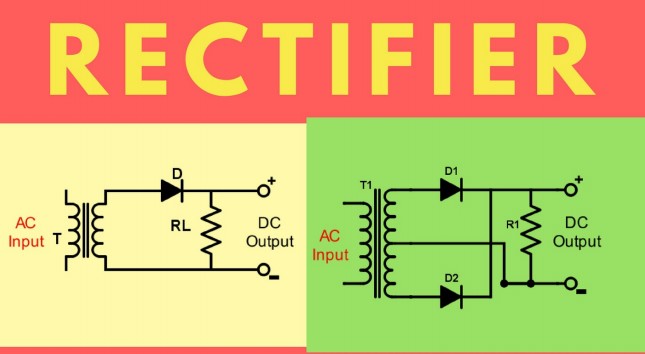Rectifiers in Electronics

A rectifier is a device that converts alternating current (AC), which periodically reverses direction, to direct current (DC), which flows in only one direction. The process is known as rectification. Rectifiers use electronic elements like diodes to achieve this conversion. Diodes allow current to flow more easily in one direction than the other, making them ideal for rectification tasks.
Rectifiers can be single-phase or multi-phase (most commonly three-phase) and range from simple designs using a single diode, for low power applications, to complex bridge rectifiers using multiple diodes, for high power applications. The output of the rectifier is typically smoothed by an electronic filter to produce a more steady DC output. Rectifiers are widely used in power supplies for electronic devices, in battery charging circuits, and in high-voltage direct current (HVDC) power transmission systems.
Rectifiers are broadly categorized based on the configuration of diodes, the number of phases of the AC supply they can handle, and their application. Here are the primary types of rectifiers:
Half-Wave Rectifier: Utilizes only one half of the AC cycle, either positive or negative, to produce DC. It is the simplest form of rectifier, consisting of a single diode.
Full-Wave Rectifier: Converts both halves of the AC cycle into DC. It is more efficient than a half-wave rectifier and produces a smoother DC output. Full-wave rectifiers can be further divided into two main types:
Center-Tapped Full-Wave Rectifier: Uses a center-tapped transformer and two diodes, where each diode rectifies one half of the AC cycle.
Bridge Rectifier: Utilizes four diodes arranged in a bridge configuration to rectify both halves of the AC cycle without the need for a center-tapped transformer. A specific type of full-wave rectifier that uses four diodes in a bridge configuration. It is the most common form of rectifier for converting AC to DC in many electronic devices due to its efficiency and the absence of a requirement for a center-tapped transformer.
Three-Phase Rectifier: Designed to rectify the output from a three-phase AC supply. Three-phase rectifiers are more efficient and have a smoother output than single-phase rectifiers. They are commonly used in industrial applications, where three-phase power is standard. There are several configurations for three-phase rectifiers, including:
Three-Phase Half-Wave Rectifier: Uses three diodes, one for each phase.
Three-Phase Full-Wave Bridge Rectifier: Uses six diodes, arranged in a bridge configuration for higher efficiency and smoother output.
Controlled Rectifiers: These rectifiers use controllable devices like thyristors (SCRs), triacs, or transistors instead of diodes. The output DC voltage can be varied by controlling the firing angle of the SCRs. Controlled rectifiers can be single-phase or three-phase and are used in applications where it is necessary to control the output voltage, such as in motor speed controllers, power supplies, and battery charging systems.
Precision Rectifiers: These are designed to rectify signals with very low amplitudes that standard diode rectifiers cannot handle without significant voltage loss. Precision rectifiers use operational amplifiers in conjunction with diodes to achieve this, allowing for the rectification of low-level signals without losing their amplitude.
Each type of rectifier serves specific applications based on factors such as the required smoothness of the DC output, efficiency, cost, and complexity. The choice of rectifier is critical in designing power supplies, electronic circuits, and electrical systems that require DC power.

